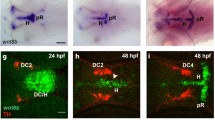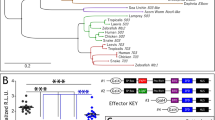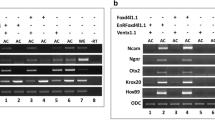Abstract
FoxG1 is an evolutionarily conserved, winged-helix transcriptional repressor that maintains progenitor cells in the vertebrate forebrain. How the activity of FoxG1 is regulated is not known. Here, we report that in the developing Xenopus and mouse forebrain, FoxG1 is nuclear in progenitor cells but cytoplasmic in differentiating cells. The subcellular localisation of FoxG1 is regulated at the post-translational level by casein kinase I (CKI) and fibroblast growth factor (FGF) signalling. CKI phosphorylation of Ser 19 of FoxG1 promotes nuclear import, whereas FGF-induced phosphorylation of Thr 226 promotes nuclear export. Interestingly, FGF-induced phosphorylation of FoxG1 is mediated Akt kinase (also known as protein B kinase, PKB) kinase, rather than the MAPK pathway. Phosphorylation of endogenous FoxG1 is blocked by CKI and Akt inhibitors. In the mouse olfactory placode cell line OP27, and in cortical progenitors, increased FGF signalling causes FoxG1 to exit the nucleus and promotes neuronal differentiation, whereas FGF and Akt inhibitors block this effect. Thus, CKI and FGF signalling converge on an antagonistic regulation of FoxG1, which in turn controls neurogenesis in the forebrain.
This is a preview of subscription content, access via your institution
Access options
Subscribe to this journal
Receive 12 print issues and online access
$209.00 per year
only $17.42 per issue
Buy this article
- Purchase on Springer Link
- Instant access to full article PDF
Prices may be subject to local taxes which are calculated during checkout





Similar content being viewed by others
References
Kaestner, K. H., Knochel, W. & Martinez, D. E. Unified nomenclature for the winged helix/forkhead transcription factors. Genes Dev. 14, 142–146 (2000).
Xuan, S. et al. Winged helix transcription factor BF-1 is essential for the development of the cerebral hemispheres. Neuron 14, 1141–1152 (1995).
Bourguignon, C., Li, J. & Papalopulu, N. XBF-1, a winged helix transcription factor with dual activity, has a role in positioning neurogenesis in Xenopus competent ectoderm. Development 125, 4889–900 (1998).
Hanashima, C., Li, S. C., Shen, L., Lai, E. & Fishell, G. Foxg1 suppresses early cortical cell fate. Science 303, 56–59 (2004).
Shen, Q. et al. The timing of cortical neurogenesis is encoded within lineages of individual progenitor cells. Nature Neurosci. 9, 743–751 (2006).
Li, J., Thurm, H., Chang, H. W., Iacovoni, J. S. & Vogt, P. K. Oncogenic transformation induced by the Qin protein is correlated with transcriptional repression. Proc. Natl Acad. Sci. USA 94, 10885–10888 (1997).
Dou, C. et al. BF-1 interferes with transforming growth factor β signaling by associating with Smad partners. Mol. Cell Biol. 20, 6201–6211 (2000).
Rodriguez, C. et al. Functional cloning of the proto-oncogene brain factor-1 (BF-1) as a Smad-binding antagonist of transforming growth factor-β signaling. J. Biol. Chem. 276, 30224–30230 (2001).
Yao, J., Lai, E. & Stifani, S. The winged-helix protein brain factor 1 interacts with groucho and hes proteins to repress transcription. Mol. Cell Biol. 21, 1962–1972 (2001).
Hanashima, C., Shen, L., Li, S. C. & Lai, E. Brain factor-1 controls the proliferation and differentiation of neocortical progenitor cells through independent mechanisms. J. Neurosci. 22, 6526–6536 (2002).
Seoane, J., Le, H. V., Shen, L., Anderson, S. A. & Massague, J. Integration of Smad and forkhead pathways in the control of neuroepithelial and glioblastoma cell proliferation. Cell 117, 211–223 (2004).
Hardcastle, Z. & Papalopulu, N. Distinct effects of XBF-1 in regulating the cell cycle inhibitor p27(XIC1) and imparting a neural fate. Development 127, 1303–1314 (2000).
Papalopulu, N. & Kintner, C. A posteriorising factor, retinoic acid, reveals that anteroposterior patterning controls the timing of neuronal differentiation in Xenopus neuroectoderm. Development 122, 3409–3418 (1996).
Campbell, K. Cortical neuron specification: it has its time and place. Neuron 46, 373–376 (2005).
Sonderegger, C. K. & Vogt, P. K. Binding of the corepressor TLE1 to Qin enhances Qin-mediated transformation of chicken embryo fibroblasts. Oncogene 22, 1749–1757 (2003).
Marcal, N. et al. Antagonistic effects of Grg6 and Groucho/TLE on the transcription repression activity of brain factor 1/FoxG1 and cortical neuron differentiation. Mol. Cell Biol. 25, 10916–10929 (2005).
Flotow, H. & Roach, P. J. Role of acidic residues as substrate determinants for casein kinase I. J. Biol. Chem. 266, 3724–3727 (1991).
Gross, S. D. & Anderson, R. A. Casein kinase I: spatial organization and positioning of a multifunctional protein kinase family. Cell Signal. 10, 699–711 (1998).
Voigt, J., Chen, J. A., Gilchrist, M., Amaya, E. & Papalopulu, N. Expression cloning screening of a unique and full-length set of cDNA clones is an efficient method to identify gene function in Xenopus neurogenesis. Mech. Dev. 122, 307–311 (2005).
Rena, G., Bain, J., Elliott, M. & Cohen, P. D4476, a cell-permeant inhibitor of CKI, suppresses the site-specific phosphorylation and nuclear exclusion of FOXO1a. EMBO Rep 5, 60–65 (2004).
Zheng, W., Nowakowski, R. S. & Vaccarino, F. M. Fibroblast growth factor 2 is required for maintaining the neural stem cell pool in the mouse brain subventricular zone. Dev. Neurosci. 26, 181–196 (2004).
Raballo, R. et al. Basic fibroblast growth factor (Fgf2) is necessary for cell proliferation and neurogenesis in the developing cerebral cortex. J. Neurosci. 20, 5012–5023 (2000).
Dono, R., Texido, G., Dussel, R., Ehmke, H. & Zeller, R. Impaired cerebral cortex development and blood pressure regulation in FGF-2-deficient mice. EMBO J. 17, 4213–4225 (1998).
Temple, S. & Qian, X. bFGF, neurotrophins, and the control or cortical neurogenesis. Neuron 15, 249–252 (1995).
Vaccarino, F. M., Ganat, Y., Zhang, Y. & Zheng, W. Stem cells in neurodevelopment and plasticity. Neuropsychopharmacology 25, 805–815 (2001).
Nutt, S. L., Dingwell, K. S., Holt, C. E. & Amaya, E. Xenopus Sprouty2 inhibits FGF-mediated gastrulation movements but does not affect mesoderm induction and patterning. Genes Dev. 15, 1152–1166 (2001).
Alessi, D. R., Caudwell, F. B., Andjelkovic, M., Hemmings, B. A. & Cohen, P. Molecular basis for the substrate specificity of protein kinase B; comparison with MAPKAP kinase-1 and p70 S6 kinase. FEBS Lett 399, 333–338 (1996).
Davis, R. J. The mitogen-activated protein kinase signal transduction pathway. J. Biol. Chem. 268, 14553–14556 (1993).
Eswarakumar, V. P., Lax, I. & Schlessinger, J. Cellular signaling by fibroblast growth factor receptors. Cytokine Growth Factor Rev. 16, 139–149 (2005).
Downward, J. Targeting RAS signalling pathways in cancer therapy. Nature Rev. Cancer 3, 11–22 (2003).
Datta, S. R., Brunet, A. & Greenberg, M. E. Cellular survival: a play in three Akts. Genes Dev. 13, 2905–2927 (1999).
Woods, Y. L. & Rena, G. Effect of multiple phosphorylation events on the transcription factors FKHR, FKHRL1 and AFX. Biochem. Soc. Trans. 30, 391–397 (2002).
Burgering, B. M. & Medema, R. H. Decisions on life and death: FOXO Forkhead transcription factors are in command when PKB/Akt is off duty. J. Leukoc. Biol. 73, 689–701 (2003).
Illing, N. et al. Conditionally immortalized clonal cell lines from the mouse olfactory placode differentiate into olfactory receptor neurons. Mol. Cell Neurosci. 20, 225–243 (2002).
Zhang, C. et al. Repression of nodal expression by maternal B1-type SOXs regulates germ layer formation in Xenopus and zebrafish. Dev. Biol. 273, 23–37 (2004).
Acknowledgements
We thank K. Dorey and E. Amaya for discussions. N.P. is a Wellcome Trust Senior Research Fellow. T.R. was, and M.R. is, a Wellcome Trust Research Associate. This work was funded by the Wellcome Trust. N.I. and N.B. acknowledge support from the National Research Foundation and Medical Research Council of South Africa.
Author information
Authors and Affiliations
Contributions
T.R. made the constructs, and performed and analysed all the biochemical and most immunostaining experiments. M.R. performed the in situ hybridizations. N.B. and N.I performed and analysed the OP27 experiments. N.P. planned the project, directed the research and wrote the manuscript.
Corresponding author
Ethics declarations
Competing interests
The authors declare no competing financial interests.
Supplementary information
Supplementary Information
Supplementary Information Figure S1, S2, S3, S4, S5 and S6 (PDF 1157 kb)
Rights and permissions
About this article
Cite this article
Regad, T., Roth, M., Bredenkamp, N. et al. The neural progenitor-specifying activity of FoxG1 is antagonistically regulated by CKI and FGF. Nat Cell Biol 9, 531–540 (2007). https://doi.org/10.1038/ncb1573
Received:
Accepted:
Published:
Issue Date:
DOI: https://doi.org/10.1038/ncb1573
This article is cited by
-
Transcriptional and Epigenetic Control of Mammalian Olfactory Epithelium Development
Molecular Neurobiology (2018)
-
Emerging Monogenic Complex Hyperkinetic Disorders
Current Neurology and Neuroscience Reports (2017)
-
Imbalance of excitatory/inhibitory synaptic protein expression in iPSC-derived neurons from FOXG1+/− patients and in foxg1+/− mice
European Journal of Human Genetics (2016)
-
An AKT3-FOXG1-reelin network underlies defective migration in human focal malformations of cortical development
Nature Medicine (2015)
-
Induced neural stem/precursor cells for fundamental studies and potential application in neurodegenerative diseases
Neuroscience Bulletin (2015)



